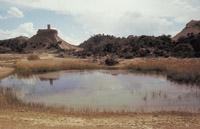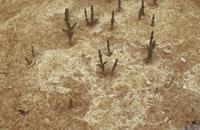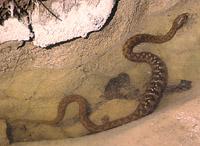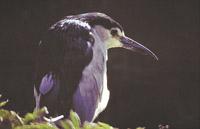Wetlands of the Basque Country (VIII): endorheic lagoons of the interior

While on its shores were accumulated thick detritic deposits, in the center were forming layers of evaporites due to the characteristics of the saline sedimentary media. During Mioceno, when the Ebro River drilled the Catalan coastal saw, this large lake emptied, leaving small lagoons and endorheic lagoons in depressions without natural drainage.
This is the origin of numerous endorheic wetlands located in the Ebro depression. However, there are others who have formed later as a result of the wear of soft, hard materials.
They are circular or elliptic lagoons of salt water. The margins are of soft slope and at water level the slope is reduced. Because these endorheic systems are shallow, in the water column there is no stratification process and a small wind run is enough to mix all the water mass. To some extent, it can be said that the characteristics of the margins extend to the entire surface of the wetland, since there are no well-differentiated pelagic zones (open water zone) or benthic zones (deep and unluminous bottoms).
These ponds rest on substrates formed by sandstones, clays and waterproof sludge, which are usually filled with runoff water and are seasonal, that is, they are filled with winter rainwater, but in summer, when the water evaporates, they are empty. The water is transparent and very mineralized, since before reaching the pools the rainwater cleans the substrate with abundant salt. In summer, due to the aridity of these regions, the water evaporates, then the salts accumulate in white crusts and the area of the ponds acquires a striking white color.
The fluctuations of the aforementioned water level and the high salinity of the substrate are unsustainable conditions for most living beings. However, few species have adapted to live in these harsh living conditions. Due to the surprising physiological and morphological adaptations that these species have developed to live in these saline means, they are considered to be species of high ecological value. Unfortunately, the great specialization involved in obtaining these adaptations has made them very sensitive to the disaster of the place of residence. This strict relationship with the place of residence and the transformations that the human being has experienced for a long time in order to use the waters of these wetlands have made the situation of the endorheic lagoons and the communities of living beings that inhabit them really worrying.
Vegetation vegetation vegetation vegetation vegetation vegetation vegetation

As mentioned above, the plants that inhabit the endorheic ponds must face the harsh conditions of life that imposes the level of water and, above all, the salinity of water and substrate. These conditions are very similar to those of the rías, so, although it seems to be a lie, in the lagoons and endorheic buckets of the most arid region of the Basque Country and in the coastal marshes very similar plant communities are developed. However, as it happens in marshes, not all these plants have the same tolerance to fluctuations of water and salinity, so they are organized in vegetable rings from the center to the outside of the ponds.
If the lagoons have an area always submerged, a vegetable community can appear composed mainly of seaweed Chara foetida and ears of pink flowers that leave the water, Polygonum amphibium.
Somewhat higher is the area with high levels of freatics and brackish ponds. In it is found the halohigrófilo vegetal ring formed mainly by Salicornia ramosisima and plants squeezed from the year Suaedo esplendis.
The next vegetable ring is developed in the area where the immersion is ephemeral and is formed by sustainable wood plants, which facilitates its detection. In this plant community predominates the species Suaeda vera.
On the banks of the ponds, but in a very rare area under water, there is a community formed mainly by halogen plant species of Limonium viciosoi, Limonium ruizii and Inula crithmoides. Among these last two communities, due to the highest salt concentration of the substrate, it lives in the clearings that usually stop a special community composed of annual halophilic plant species. In this community there is a greater plant diversity. Among the most abundant species are: Frankenya pulvurulenta, Sphenopus divaricatus, Parapholis incurva, Spergularia diandra, Hymenolobus procumbens, Hordeum marinum...
From here the salinity of the substrate is null and the water almost never reaches that level, but the water level is quite high. In these zones the potential vegetation is formed mainly by the militias of the shrub species Tamarix canadiensis and African Tamarix. Unfortunately, in these areas the agricultural pressure is very high and, in most cases, it has reached the part that should fulfill the cultivation of these miracles.
Finally, it is worth mentioning the development of compact ponds on the banks of several endorheic lagoons, usually altered by human action or receiving some fresh water flow. These carriages, besides the species of carrizo Phragmites australis, are formed by Scirpus maritimus, Juncus maritimus, Atriplex hastata, Puccinellia festuciformes, Cladium mariscus, etc.
Fauna and fauna Fauna of the Andes

The precariousness, the relative turbidity, the high mineralization and the great seasonal variability that characterize the endorheic lagoons make it develop in them singular and very interesting communities of the zooplankton. Within these communities, crustaceans are of great importance. Among them are the following species: Copepods Mixodiaptomus incrassatus and Metacyclops minutus, cladoceros Daphnia atkinsoni and Moina brachiata and the anostráceo Branchipuz schaefferi.
As for fish, although the precariousness of the endorheic lagoons preserved in a natural state and the scarce depth of water prevent the development of fish communities, in areas humanized by small dams, inhabit various species of fish. A few (eel, common barb and northern loin) can come from adjacent rivers, but the rest (rainbow trout, tenca, common zamo, American perch, common zamo and pike) are exotic species introduced by man.
On the other hand, we cannot forget that these ponds are in areas of great fragility, since many animal species of these areas become true oasis. In the case of vertebrates, endorheic ponds play a fundamental role in the maintenance of amphibian populations, since, despite the fact that the precariousness causes a high mortality among the larvae of amphibians, they are almost the only zones found in these regions to be able to reproduce. Among the species of amphibians that reproduce in the endorheic coffers of Euskal Herria stand out the triton marmolaire, the frog of common trees, the mottled toad, the painted toad, the spur toad, the txantxikua and the corridor toad.
The reproduction outside the water has made many reptiles have adapted to live in arid areas. However, for species with some dependence or fondness to water, the importance of endorheic ponds in these areas is important. Undoubtedly, the serpent vespers with aquatic life is the most abundant reptile of these ponds, but it is not usually difficult to observe, hidden among the plants of the banks, other species of a certain hygrophilous character, such as the snake corbata or the smooth north serpent.
However, as occurs in most wetlands, in endorheic ponds, birds, in addition to being part of the fauna with greater diversity, constitute the most striking aspect. The diversity of birds is not the same throughout the year. In fact, as a result of the migrations of birds already commented, according to the time of the year, the composition of the ornitofauna observed in the endorheic pools is quite variable. The highest abundances and diversity occur in autumn. Then, many of the aquatic birds that are making a postnuptial migration take advantage to rest and feed on the oasis pools of these arid lands. At this time of year it is easy to observe in large groups numerous species of birds associated with aquatic ecosystems (borderlands, ardeids, annealed birds...). In spring, when birds carry out prenuptial migration, this phenomenon is less pronounced due to the most appropriate weather conditions, which accelerate return migration.

In summer, both abundance and diversity descend much, but instead, some rather rare species as nidificantes in the Basque Country nest in these ponds. Among them are the Txilimporta-Txiki and the Txilindi Lepabeltza; the Amiltxori Txikia, the Common Amiltxori, the Common Bull Bird and the Red Garceta; the Common Chicken and the Zancudo; the Common Duck, the Common Duck and the Crujiente. It is worth mentioning the importance of the lagoons and endorheic buckets that appear in the Bardenas of Navarre, a typical figure of the summer on whose shores are seen the vaults of crosses, the buckets, the thresholds, some specimens of the small and large sketch in danger of extinction and other species of steparian birds.
Finally, it should be noted that numerous species of analogue and ditch choose these endorheic ponds to winter. Among the first, stand out the common fence, the clayey duck, the txistulari duck and the crushed porrón, while among the ditches stand out the cold, the common agachón and the small, the great zarapito, the common gold or the dark oak.
Buletina
Bidali zure helbide elektronikoa eta jaso asteroko buletina zure sarrera-ontzian










